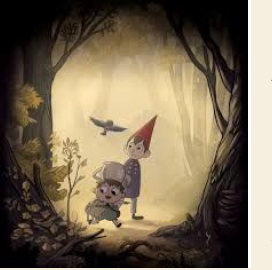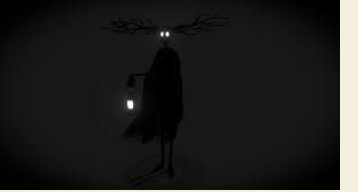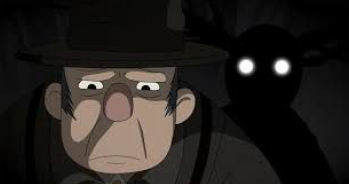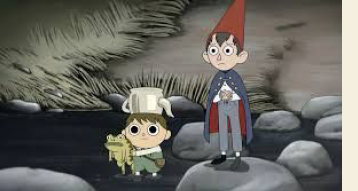By Mackenzie Clark

When people think of fairy tales today, they often think of the Disney versions that we grew up watching. Disney fairy tales are known for colorful animation, fun musical numbers, and above all a happy ending. And at first glance, the 2014 Cartoon Network miniseries Over the Garden Wall seems to follow these same tropes. It is animated, there are musical numbers, and I guess you could say it has a happy ending. But the animation is darker and more mysterious, the musical numbers are either folksy or sweeping and orchestral, and the final message of the show is really about death and dying, and the conscious choice to carry on living even in times of misfortune. I know what you’re thinking: This show doesn’t sound nearly as fun as a Disney movie. But after watching it many, many…many times, I have come to the conclusion that this show is a beautiful modernization of a Grimm fairy tale and can offer something to everyone, no matter their age.
Over the Garden Wall begins with two brothers, Wirt and Greg, wandering through a strange forest, which the narrator names “The Unknown.” They do not remember how they got to this forest or how to get home. In the first episode, they meet a girl-turned-bluebird named Beatrice who claims she can help them escape the forest, and the rest of the show follows their adventures trying to do just that while avoiding the mysterious antagonist known only as “The Beast.”

On the surface, Over the Garden Wall is similar to a lot of 19th century fairy tales. It involves two young children lost in the woods, reminiscent of “Hansel and Gretel” or “Little Red Riding Hood,” people cursed to take the form of animals, as in stories like “The Frog Prince”, and a mysterious woodsman, like in “Snow White.” The setting is hard to place but looks similar to the average person’s idea of Puritan America: farms, small towns, no technology. But the show manages to subvert traditional fairy tale tropes as well. While Wirt and Greg are clearly the Hero and Helper archetypes and the Beast is the obvious Villain, the other characters are much more complex.

One hilarious example of this is Sara, Wirt’s love interest. Throughout the show, Wirt refers to his unrequited love and laments the fact that he believes Sara likes another boy, Jason Funderberker, instead. He paints Jason as the stereotypical cool kid. But when we finally meet the two of them, Jason is nerdy and has a grating voice that immediately gets on your nerves, while Sara is clearly more interested in Wirt. Similarly, many characters blur the line between good and evil. We find out the Woodsman is helping the Beast, which is upsetting until we find out he is only doing so to save his daughter. We also learn that Beatrice, someone who has been our ally, is tricking the two boys, but only because she is trying to help her family escape a curse.

Many Grimm’s fairy tales are also rooted in religion, Christianity specifically, something Over the Garden Wall leans into. The Unknown itself is a type of Purgatory. The audience discovers this towards the end of the series when it is revealed that Greg and Wirt are actually from modern times. When hanging out with their friends on Halloween night, the two fall into a lake. As they sink to the bottom, they are transported to the Unknown. The purpose of the show is for Greg and Wirt to make a decision: do they continue to wander the Unknown and give into its temptations, or do they choose to return to the real world and continue living?
The Beast is a religious figure as well, more specifically a Satanic figure. He is the agent of death throughout the show. A terrifying monster who collects the souls of lost children. The Unknown acts as the Beast’s mechanism to trap people. Its forest is endless and the more you journey through it, the more hopeless you become until you finally give up. Most do not have the strength to outlast the Beast and he has clearly claimed many lives.

One life the Beast has allegedly claimed involves a character called the Woodsman. The boys meet the Woodsman in the very first episode. He tells them that his lot in life is to find the edelwood trees and grind up their branches to make oil to keep his lantern lit. Why? The Beast has trapped his daughter’s soul within the lantern, and tells him that keeping it lit is the only way to keep some semblance of her alive. Is this really living though? I’m not sure it’s a life many would choose. But the fear of loss is crippling for the Woodsman, and probably the
audience themselves, and the Beast plays on this fear even further by asking the Woodsman to lead him to the two boys. If he can do this, the Beast claims he will see his daughter again. A life for a life.
Greg is our symbol of optimism throughout the show while his brother slowly starts to lose the will to carry on. Seeing that Wirt is about to be claimed, Greg makes a deal with the Beast. The Beast has Greg do various complex tasks, clearly designed to wear him down. At one point, the Beast tells him, “I thought you’d give up,” and Greg responds, “Give up? I’ll never give up.” Greg’s unwavering optimism allows him to refuse to give in to the Beast and, by extension, death. He is too excited about life to want it to end any time soon, no matter how hopeless things seem. He is making a conscious choice to continue to live.

Eventually however, the Beast is able to trick him into staying still long enough for a tree to begin to grow around him, trapping him in the forest. When Wirt finds him, he is weak and seemingly close to death. While Wirt tries to save him, the Beast calls the Woodsman. Greg has turned into an edelwood tree at the perfect time: the Woodsman is running out of oil. The realization on the Woodsman’s part that he has been burning children’s souls is a heartbreaking one and shows the cruelty and manipulation of the Beast. When the Woodsman protests
that he did not know, the Beast replies, “And would it have mattered?” This touches on a chilling theme: the love that a parent has for a child or that Greg and Wirt have for each other, seems to overshadow any bad deeds. They are willing to do anything for each other, even if that means causing the deaths of others, at least that is the Beast’s idea.
The Beast finally tries to conclude his plan: he wants Wirt to take on the task of lantern-bearer, keeping Greg’s soul alive inside the lantern. On the brink of giving in, Wirt suddenly has an epiphany, and a funny one at that. His heroic and defiant words are, “Wait, that’s dumb.” If he agrees to be the lantern-bearer, he would be trapped in the Unknown as well. That is not what Greg would have wanted. Even in the face of serious loss, Wirt has to choose to continue living. He gives the lantern back to the Woodsman, and after choosing to live, escape is suddenly easy. He and Greg leave the Beast behind. Suddenly, the two wake up in the hospital, having been rescued from their near-death experience.

Classic fairy tales always have some sort of moral. This is why they were so popular. Children and adults alike could read them and get something relevant out of them. And the moral of Over the Garden Wall is clear. This show equates giving up to dying, and that death is a scary one, filled with monsters. So no matter what happens, you have to push through. Never give up, even in the face of seemingly insurmountable obstacles. In short, be more like Greg. This is something Wirt learns to do throughout the show and it pays off. The two return home stronger, braver, and more prepared for the world ahead of them than ever.
Many finish this show and are stuck on one particular question. Was the Unknown ever actually real? And to that, I’ll leave you with the words of the Beast: Would it have mattered? Watch the show, explore the magic of this strange and beautiful world, see what you take away from it. And then hopefully, you’ll have your answer.
